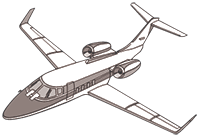A Pilot's Guide to Ground Icing
Module IV - De-Icing Operations
How to take it off
Section: Mechanical De-Icing
Start This SectionMechanical De-Icing De-Icing Operations
If, during your preflight inspection, you find frozen contamination on your aircraft surfaces, you’ll need to clean it off, or de-ice it, prior to flight. By definition, de-icing is the process by which frost, snow, ice or slush is completely removed from the surface of the aircraft.
The optimum de-icing approach typically depends on size of aircraft and funds available. De-icing can be accomplished by several means:
- Heated Hangar
- Mechanical/Thermal means (broom, hot air)
- De-icing fluid
If you cannot completely remove the contamination, don’t fly. It’s that simple.
Further Information
Infrared (IR) Hangars
Infrared, or IR, hangars exist at select airports. This technology uses the radiant heat in the infrared wavelength to warm aircraft surfaces and melt frozen contamination; and can significantly reduce glycol usage. IR is for de-icing only. If there is freezing precipitation, an anti-icing fluid application is still required. This technology is fairly new and only exists at a few larger airports. Refer to FAA AC 120-89 for more information.

Infrared hangar at Newark, NJ, USA (Photo courtesy of Radiant Energy Corp.)

FAA Regulation & Policies
FAR 91.527, "Operating in Icing Conditions"
ACC 135-17-018, "Pilot Guide: Ground Operations in Icing Conditions for Smaller Aircraft"

Canadian Aviation Regulations (CARs)
CAR 602.11 & 622.11
"TP 10643 - When in Doubt... Small and Large Aircraft - Aircraft Critical Surface Contamination Training for Aircrew and Groundcrew"
see "TP 14052 Guidelines for Aircraft Ground Icing Operations"

JAR Ops 1.345(b)
AEA "Recommendations for De-Icing / Anti-Icing of Aircraft on the Ground"
Mechanical De-Icing De-Icing Operations
Hangar
A heated hangar can be used to melt off frozen contaminants. Beware, however, of pulling your warm aircraft into snow or other precipitation at below freezing temperatures. The precipitation will melt and may refreeze before you can takeoff, especially on a fully fueled, warm wing.
Also be aware that pulling a clean, dry aircraft from an unheated hangar into very dry, very cold (< -10C) snow conditions may not require any de/anti-icing action. A dry, cold snow will not stick to a dry, clean aircraft. Verify by touch that the snow is not adhering.
Mechanical De-Icing De-Icing Operations
Mechanical/Thermal Means
If you cannot protect your aircraft, and the surfaces become contaminated, you will need to de-ice. In many circumstances, mechanical and thermal means can be used to remove the majority of the contamination. Examples of de-icing with such tools include broom or squeegee, ropes, hot air and/or forced air.
These mechanical and thermal means are the best methods to de-ice your aircraft's no spray zones.
Further Information
Brooms and/or squeegees are good tools to clean the majority of smaller aircraft. They should be used in a pulling motion from leading edge to trailing edge on the wing. Make sure that the control surface gaps are clear. Take care to protect sensors and antennas protruding from the skin.
Warning

Left: Use a pulling motion from leading edge to trailing edge. Right: Snow removal with broom on high wing aircraft.
Consider these broom and squeegee tips:
- Wrap the handle with soft foam or cloth to help protect the aircraft skin from dings and dents.
- Do not use the same broom/squeegee that also cleans the floor. You don't want bits of metal or oily contamination on the skin of your aircraft.
- Modify the broom so that the brush head is at a 90 degree angle to the handle. This facilitates snow removal from high surfaces.
- Stiff brown bristles in a wooden head survive longer than soft plastic bristles in a plastic head. They are also more effective at removing frost.
Ropes are sometimes used to remove contam-ination (usually light frost) from wings and horizontal tailplanes. The method requires two people seesawing the rope back and forth across the surface to remove the contaminants.
Warning

Pilots removing snow and light frost from aircraft wing using ropes.
Hot air, say from an engine preheater, can be used to clean water that may have frozen inside a spinner, propellers, engine intake areas, and landing gear.

If ice has accumulated on fan blades, hot air is the only method to clean this deep inside the engine area.
If you need to remove ice from the aircraft skin, hot air might be a good choice. But, take care not to overheat one spot.

Hot air cleaning the engine area
Heavy accumulations of snow can be removed from aircraft surfaces with the use of a heavy-duty air compressor. A cold air blast can be directed from a safe distance of 5 to 20 feet depending on air pressure used.
Warning

De-icing truck equipped with a Forced Air Deicing System (FADS)
Related Information
Peter Shaw, Chief Maintenance Engineer, White Waltham Airfield, UK




